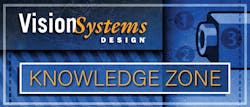Deep learning in machine vision
Question:
How does deep learning work for machine vision? What's the difference between traditional machine vision and deep learning add-on vision systems?
Answer:
Deep learning in imaging is very effective in comparison, classification, and differentiation. (Consider the classic "Google" environment where one wishes to get all pictures of a "cat.” This is an over-simplification, but essentially a deep learning system has processed the millions of available images and classified the appropriate ones as "cat" images.)
In industrial machine vision, deep learning can be very successful at the same things. A machine learning system can be trained with a large sample of images of good parts and a large sample of images with differences (defects, wrong features, etc.) and based on the learning, the system will be able to identify good parts vs. bad parts, even when the feature or defect on the bad part is new and has not previously been discretely trained.
Deep learning will be a useful tool for these types of applications, but it is not well indicated in all cases. The many applications where discrete object analysis (like guidance, location, metrology, etc.) are not good candidates for deep learning.
This was adapted from the Vision Systems Design webcast “Introduction to machine vision: Definitions, components, benefits, applications,” presented by David Dechow, Principal Vision Systems Architect, Integro Technologies. View archived and upcoming webcasts here.
